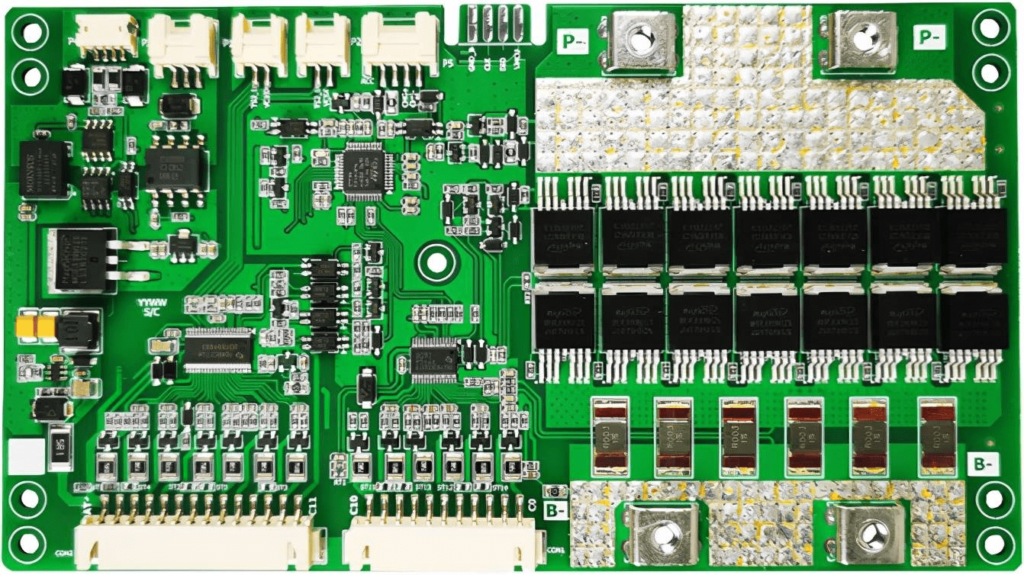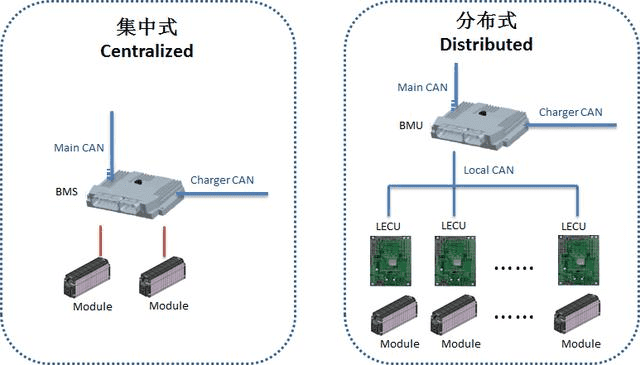BMS stands for Battery Management System. It is used for monitoring, evaluating, and managing batteries. In the context of lithium-ion battery packs, the BMS is typically a circuit board.

Hardware Topology of BMS:
BMS hardware architecture can be divided into two main types: centralized and distributed.

Centralized: This architecture collects data from all the cells in a unified manner. It is suitable for scenarios with a low number of cells. The advantage of this architecture is that it has a simple circuit design and lower cost. However, it has some limitations, such as longer wiring for individual cell sampling, complex sampling wire design, and limited sampling channels. It is suitable for applications with lower capacity, lower total voltage, and smaller battery pack size.
Distributed: This architecture includes a mainboard and subboards. The advantage is that the sampling wire distances are more even, but it comes at a higher cost and requires additional chips to transmit information from various modules to the BMS mainboard. As electric vehicle battery systems move towards higher capacity, total voltage, and larger size, the distributed architecture is mainly used in plug-in hybrids and pure electric vehicle models.
Functions of BMS:
onitoring Battery Charge/Discharge Status: BMS monitors real-time battery parameters, including voltage, current, and capacity.
Overcharge Protection: When charging, if the battery voltage exceeds the safe range, the BMS will disconnect the charging circuit to prevent overcharging.
Over-Discharge Protection: During discharge, if the battery voltage drops below a safe threshold, the BMS will disconnect the discharge circuit to prevent over-discharge.
Temperature Protection: BMS uses temperature sensors to monitor battery temperature. If it gets too high or too low, the BMS takes measures to protect the battery.
Balancing Management: BMS ensures that individual cells within a battery pack have similar voltage levels, improving the overall performance and lifespan of the battery pack.
How BMS Works:
A typical Battery Management System consists of a central processing unit, data acquisition module, data monitoring module, display unit, and control components. It uses an internal CAN bus technology for communication between modules. The central control module is responsible for system management and control, similar to the brain controlling thoughts and communicating with the body. The terminal module is responsible for data collection, including voltage, current, temperature, and signals. The display module presents data for user interaction. This combination of modules enables battery parameter detection, battery status estimation, real-time fault diagnosis, battery safety control and alarms, charge control, battery balancing, thermal management, network communication, data storage, electromagnetic compatibility, and more.
Importance of BMS:
BMS is essential for the safe and reliable operation of a battery system. It extends battery life, improves performance, ensures safety, conserves energy, and makes monitoring and maintenance easier. Without a BMS, lithium-ion batteries are more vulnerable to overcharging, over-discharging, overheating, and other potential risks.
Choosing the Right BMS:
Confirm Voltage: Determine the battery pack’s voltage based on the number of cells in series. Different lithium-ion battery types have different nominal voltages.
Confirm Current: Choose a BMS with a current rating greater than the controller’s maximum current draw.
Confirm C-Rating: Ensure the BMS can handle the discharge rate (C-rating) of the battery pack.
Selecting the right BMS ensures that the battery pack operates safely and efficiently within the specified parameters.


